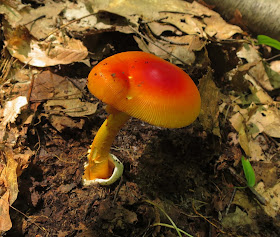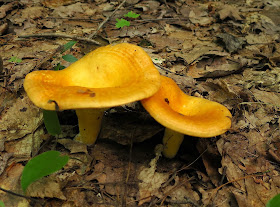Rain, rain, rain! I can't remember a summer more rainy than this one has been so far. I'm wondering if it has discouraged some of the summer flowers from blooming, since I can't find many that I usually do. But boy, the mushrooms are lovin' it! Here's a partial array of the mushrooms and other fungi I found at Orra Phelps Nature Preserve on just one visit yesterday.
The American Caesar (Amanita jacksonii) is one of our most spectacular mushrooms, emerging like a scarlet egg from a snow-white cup and then opening into this blazing-red, yellow-rimmed cap. Wow!
The Wooly Chanterelle (Gomphus floccosus) is almost as colorful, and what an unusual shape!
No other mushrooms shouts "ORANGE!" like these vivid Mycena leailana ones do. And don't they look pretty, set off by those delicate green mosses?
What a cute little pixie cap this Lemon-yellow Waxcap (Hygrocybe flavascens) has!
Here are a couple more vivid yellow ones, as well a a pale gray one. I don't know their species, but I sure love the way they look surrounded by Foamflower leaves and a few starry sprouts of Atrichum moss.
I don't know the species name for these big golden funnels, either. I just thought they were beautiful. They might be a Lactarius mushroom, but I didn't want to destroy them by cutting across their descending gills to see if they bled white or orange latex.
These stiff little cinnamon-brown fungi with zonal caps could be Coltricia cinnamomea with the delightful common name of Fairy Stools. I liked how they were keeping company with some Yellowish Spindle fungi called Clavaria fumosa.
More of that Yellowish Spindle Coral. It reminds me of seaweed waving with the current.
There were many clumps of Coral Fungus, and ponder the guides as I may, I can never be sure which species is which. Suffice it to say there were orangey corals (probably a Ramaria species) . . .
. . . and also some yellowish ones (another Ramaria species).
And then there was one called False Coral (Tremellodendron pallidum), which is distinguished from the true corals by its blunt tips.
Here's one I just love the common name for: Jelly Babies. Their scientific name is Leotia lubrica.
These little yellow spoon-shaped fungi are called Earth Tongue (Microglossum rufum).
I don't know the name of this one. It was truly tiny, just a bit more than an inch high and tucked into some moss at the base of a tree. It looked so cute in there I did not want to take it out to determine its species by tearing it apart. You simply can't be positively certain about a mushroom's identity from a single photo. Well, maybe those Earth Tongues are distinctive enough, but most mushrooms require close examination of gills and stem and spores to attempt an identification. You also need to know if it grew on wood or soil, and if wood, what kind of tree. Plain white mushrooms like this one are especially problematic. Some of them can kill you if you eat them.
I love the White Puffball (Lycoperdon candidum), covered with tiny sharp points that look like they've been applied by an icing tip. When this fungus is ripe, that white crust cracks and falls away, revealing an interior that's the color of chocolate fudge. Despite all those associations with yummy things, this puffball is not really edible. Here's a fun fact about the genus Lycoperdon: Lycos means "wolf," and perdon means "to break wind.' Hence, the name literally means "wolf farts!" Ha ha! Well, have you ever pinched a ripe puffball and seen it fart out dark puffs of spores?
There were many boletes throughout the woods at Orra Phelps, but most were a boring tan color, not very photogenic. Wish I'd seen this one before the slugs got to it and ate through that red velvet coating that covered its lemon-yellow flesh. This was a big one, too. About as big around as a dinner plate.
OK, this is not a fungus. This is the flower of the wild onion called Ramps or Wild Leek (Allium tricoccum). It's still in bud, but it won't look much different when the buds open. Its leaves have already disappeared, and I wish the flowers would, soon, so no one could notice where they are growing and come back to poach them in the spring.

















Pretty cool.
ReplyDeleteIt has been very rainy this year
What a variety of wonderful fungi. Nature is a delight and chock full of surprises if se take the time to look. Thanks for sharing your wonderful walk in the woods.
ReplyDeleteYou certainly know your mushrooms, and you found an interesting bunch to share. We've had an excessivley rainy summer so far here too.
ReplyDeleteGreat mushroom photos. Thanks for your IDs, I've never found an adequate field guide to mushrooms, especially those which aren't edible (or could be mistaken for edibles). Adding to the difficulty of identification is the variability in appearance and the need to take spore prints for many of them.
ReplyDelete